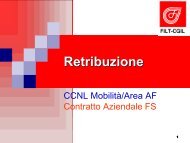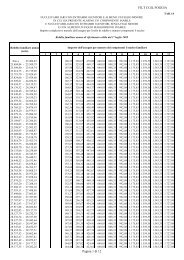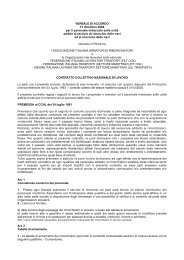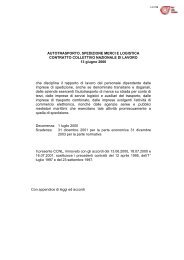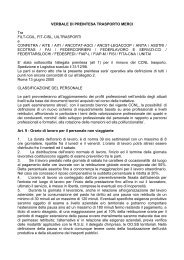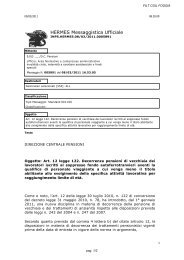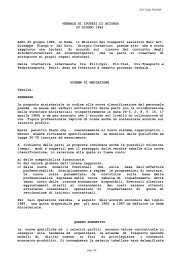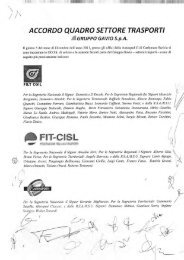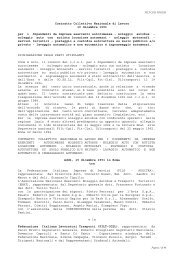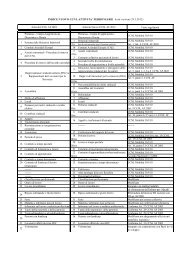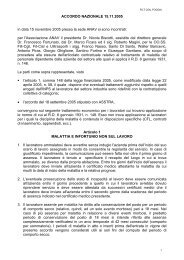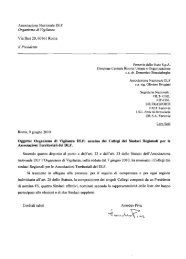Outlook for Air Transport to the Year 2025 - FILT CGIL Foggia
Outlook for Air Transport to the Year 2025 - FILT CGIL Foggia
Outlook for Air Transport to the Year 2025 - FILT CGIL Foggia
- No tags were found...
You also want an ePaper? Increase the reach of your titles
YUMPU automatically turns print PDFs into web optimized ePapers that Google loves.
Chapter 2. <strong>Air</strong> <strong>Transport</strong> Trends and Challenges 1944. At <strong>the</strong> regional level, no less than 11 groups of States have created liberalization regimes on a regionalbasis or among a group of like-minded States; a few examples being <strong>the</strong> European Union (EU), <strong>the</strong> Andean Pact,<strong>the</strong> Yamoussoukro II Ministerial decision, and <strong>the</strong> Multilateral Agreement on <strong>the</strong> Liberalization of International<strong>Air</strong> <strong>Transport</strong>ation (MALIAT) known as <strong>the</strong> “Kona” open skies agreement. There are also several o<strong>the</strong>r potentialarrangements under development throughout <strong>the</strong> world. These regional and/or plurilateral liberalizationarrangements have <strong>the</strong> basic objective of providing greater market access and improving services among <strong>the</strong>member States concerned. Small groups of States of comparable size and development may find it easier <strong>to</strong> agreeon market access than larger, diverse groups of States. The small groups would also provide a more manageableenvironment <strong>to</strong> test liberalized air transport policies.45. Along with intra-regional liberalization, interaction between regions has also been on <strong>the</strong> rise. Moresignificantly, <strong>the</strong>re has been an increase in air service negotiations involving a regional grouping on <strong>the</strong> one hand,and a State or a group of States on <strong>the</strong> o<strong>the</strong>r. In this respect, EU has been <strong>the</strong> most active, where <strong>the</strong> EuropeanCommission now is engaged in such negotiations under specific mandates on behalf of all EU member States.This approach has led <strong>to</strong> <strong>the</strong> conclusion or negotiation of several liberalized arrangements (e.g. between <strong>the</strong> EUand <strong>the</strong> United States, <strong>the</strong> EU and Morocco, and between <strong>the</strong> Association of Sou<strong>the</strong>ast Asian Nations (ASEAN)and China). Such negotiations have introduced a new dimension <strong>to</strong> aviation relations between States.46. Because of such a continuing trend of liberalization in air transport regulation, in 2005, about 20 per cent of<strong>the</strong> country-pairs with non-s<strong>to</strong>p passenger air services and almost half of <strong>the</strong> seat capacity offered occurred betweenStates which have embraced liberalization ei<strong>the</strong>r by bilateral “open skies” air services agreements or by regionalliberalized agreements and arrangements (compared with less than 4 per cent and about 20 per cent respectively in1995).47. At <strong>the</strong> multilateral level, <strong>the</strong> World Trade Organization (WTO) came in<strong>to</strong> being in January 1995 when <strong>the</strong>General Agreement on Trade in Services (GATS) entered in<strong>to</strong> <strong>for</strong>ce. The GATS Annex on <strong>Air</strong> <strong>Transport</strong> Servicesapplies trade rules and principles such as most-favoured nation (MFN) treatment and national treatment <strong>to</strong> threespecific so-called “soft” rights, namely, aircraft repair and maintenance, selling and marketing of air transport, andcomputer reservation system (CRS) services. It excludes from <strong>the</strong> application of <strong>the</strong> GATS “services directly related<strong>to</strong> <strong>the</strong> exercise of traffic rights”. Pursuant <strong>to</strong> an earlier ministerial decision, WTO launched in 2000 <strong>the</strong> first reviewof <strong>the</strong> operation of this Annex with a view <strong>to</strong> considering possible extension of its coverage in <strong>the</strong> air transportsec<strong>to</strong>r. In 2003, however, <strong>the</strong> first review was concluded with <strong>the</strong> result that <strong>the</strong> Annex remains unchanged. In 2005,WTO launched its second round of review of <strong>the</strong> Annex on <strong>Air</strong> <strong>Transport</strong> Services.48. O<strong>the</strong>r more general regula<strong>to</strong>ry measures also affect air transport. Such measures include competition law,<strong>the</strong> imposition of various taxes, <strong>the</strong> expansion of airline responsibilities associated with national entry requirements(particularly <strong>for</strong> inadmissible passengers), more stringent health standards <strong>for</strong> entry particularly where prevention of<strong>the</strong> spread of Acquired Immune Deficiency Syndrome (AIDS) and Severe Acute Respira<strong>to</strong>ry Syndrome (SARS) ando<strong>the</strong>r contagious diseases is sought, and national narcotics control ef<strong>for</strong>ts.INDUSTRY STRUCTURE49. Traditionally, changes in airline industry structure arise from <strong>the</strong> need <strong>to</strong> meet growing demand <strong>for</strong> airtransport services in increasingly competitive but less regulated markets and a more globalized economicenvironment.50. Mega-carriers in <strong>the</strong> United States and elsewhere operate out of <strong>the</strong>ir home base airports applying <strong>the</strong> “huband spoke” system which employs large banks or complexes of interconnecting flights <strong>to</strong> maximize <strong>the</strong> number ofcity-pair markets that can be served by each flight. This operational approach arose from a perceived need <strong>to</strong> operateseveral hubs and <strong>to</strong> achieve critical mass (i.e. a volume sufficient <strong>to</strong> exploit economies of scope and density, and <strong>the</strong>ability <strong>to</strong> influence market conditions). However, <strong>the</strong> hub-and-spoke concept has recently come under scrutiny as




